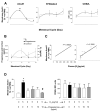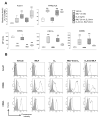Activation of the annexin A1 pathway underlies the protective effects exerted by estrogen in polymorphonuclear leukocytes
- PMID: 21836070
- PMCID: PMC3357483
- DOI: 10.1161/ATVBAHA.111.235176
Activation of the annexin A1 pathway underlies the protective effects exerted by estrogen in polymorphonuclear leukocytes
Abstract
Objective: The anti-inflammatory properties of the female sex hormone estrogen have been linked to a reduced incidence of cardiovascular disease. In the present study, we addressed whether estrogen could activate vasculoprotective mechanisms via annexin A1 (AnxA1) mobilization in human polymorphonuclear cells (PMNs).
Methods and results: Using whole-blood flow cytometry, we demonstrated that premenopausal women expressed higher levels of surface AnxA1 on circulating PMNs compared with males. This correlated with high plasma estrogen during the menstrual cycle. The addition of estrogen in vitro to male PMNs induced rapid mobilization of AnxA1, optimal at 5 ng/mL and a 30-minute incubation period; this effect was abolished in the presence of the estrogen receptor antagonist ICI182780. Estrogen addition to human PMNs induced a distinct AnxA1(hi) CD62L(lo) CD11b(lo) phenotype, and this was associated with lower cell activation as measured by microparticle formation. Treatment of human PMNs with E(2) inhibited cell adhesion to an endothelial cell monolayer under shear, which was absent when endogenous AnxA1 was neutralized. Of interest, addition of estrogen to PMNs flowed over the endothelial monolayer amplified its upregulation of AnxA1 localization on the cell surface. Finally, in a model of intravital microscopy, estrogen inhibition of white blood cell adhesion to the postcapillary venule was absent in mice nullified for AnxA1.
Conclusion: We unveil a novel AnxA1-dependent mechanism behind the inhibitory properties of estrogen on PMN activation, describing a novel phenotype with a conceivable impact on the vasculoprotective effects of this hormone.
Figures






Similar articles
-
Evidence for an anti-inflammatory loop centered on polymorphonuclear leukocyte formyl peptide receptor 2/lipoxin A4 receptor and operative in the inflamed microvasculature.J Immunol. 2011 Apr 15;186(8):4905-14. doi: 10.4049/jimmunol.1003145. Epub 2011 Mar 11. J Immunol. 2011. PMID: 21398608 Free PMC article.
-
Annexin 1 mediates the rapid anti-inflammatory effects of neutrophil-derived microparticles.Blood. 2008 Sep 15;112(6):2512-9. doi: 10.1182/blood-2008-02-140533. Epub 2008 Jul 1. Blood. 2008. PMID: 18594025
-
Investigational analysis reveals a potential role for neutrophils in giant-cell arteritis disease progression.Circ Res. 2014 Jan 17;114(2):242-8. doi: 10.1161/CIRCRESAHA.114.301374. Epub 2013 Oct 24. Circ Res. 2014. PMID: 24158630
-
Antiallergic cromones inhibit neutrophil recruitment onto vascular endothelium via annexin-A1 mobilization.Arterioscler Thromb Vasc Biol. 2010 Sep;30(9):1718-24. doi: 10.1161/ATVBAHA.110.209536. Epub 2010 Jun 17. Arterioscler Thromb Vasc Biol. 2010. PMID: 20558817 Free PMC article.
-
Annexin 1 and its bioactive peptide inhibit neutrophil-endothelium interactions under flow: indication of distinct receptor involvement.Blood. 2006 Mar 1;107(5):2123-30. doi: 10.1182/blood-2005-08-3099. Epub 2005 Nov 8. Blood. 2006. PMID: 16278303
Cited by
-
A Type A and Type D Combined Personality Typology in Essential Hypertension and Acute Coronary Syndrome Patients: Associations with Demographic, Psychological, Clinical, and Lifestyle Indicators.PLoS One. 2016 Sep 2;11(9):e0161840. doi: 10.1371/journal.pone.0161840. eCollection 2016. PLoS One. 2016. PMID: 27589065 Free PMC article.
-
Neutrophils in Post-myocardial Infarction Inflammation: Damage vs. Resolution?Front Cardiovasc Med. 2019 Mar 18;6:25. doi: 10.3389/fcvm.2019.00025. eCollection 2019. Front Cardiovasc Med. 2019. PMID: 30937305 Free PMC article. Review.
-
Sex Differences in Lung Cancer.Cancers (Basel). 2023 Jun 8;15(12):3111. doi: 10.3390/cancers15123111. Cancers (Basel). 2023. PMID: 37370722 Free PMC article. Review.
-
Role and interactions of annexin A1 and oestrogens in the manifestation of sexual dimorphisms in cerebral and systemic inflammation.Br J Pharmacol. 2013 Jun;169(3):539-53. doi: 10.1111/j.1476-5381.2012.02146.x. Br J Pharmacol. 2013. PMID: 22897118 Free PMC article.
-
Control of myeloid cell trafficking in resolution.J Innate Immun. 2013;5(4):367-76. doi: 10.1159/000350612. Epub 2013 Apr 30. J Innate Immun. 2013. PMID: 23635943 Free PMC article. Review.
References
-
- Kannel WB, Wilson P. Risk factors that attenuate the female coronary disease advantage. Arch Intern Med. 1995;155:57–61. - PubMed
-
- Bakir S, Mori T, Durand J, Chen YF, Oparil S. Estrogen-induced vasoprotection is estrogen receptor dependent: evidence from the balloon-injured rat carotid artery mode. Circulation. 2000;101:2342–2344. - PubMed
-
- Chen SJ, Li H, Durand J, Oparil S, Chen Y. Estrogen reduces myointimal proliferation after balloon injury of rat carotid artery. Circulation. 1996;93:577–584. - PubMed
-
- Sherwood A, Bower JK, McFetridge-Durdle J, Blumenthal JA, Newby LK, Hinderliter A. Age moderates the short-term effects of transdermal 17beta-estradiol on endothelium-dependent vascular function in postmenopausal women. Arterioscler Thromb Vasc. 2007;27:1782–1787. - PubMed
-
- Hayashi T, Yamada K, Esaki T, Kuzuya M, Satake S, Ishikawa T, Hidaka H, Iguchi A. Estrogen increases endothelial nitric oxide by a receptor-mediated system. Biochem Biophys. 1995;214:847–855. - PubMed
Publication types
MeSH terms
Substances
Grants and funding
LinkOut - more resources
Full Text Sources
Medical
Research Materials
Miscellaneous

